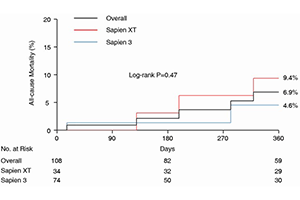Clinical outcomes and prognostic factors of transcatheter aortic valve implantation in bicuspid aortic valve patients
Abstract
Background: The purpose of this study was to evaluate the outcomes of transcatheter aortic valve replacement (TAVR) in patients with bicuspid aortic valve stenosis (AS).
Methods: From April 2012 and December 2016, 108 patients with bicuspid AS underwent TAVR using the Sapien XT (34 patients) and Sapien 3 (74 patients) valves. Procedural and clinical outcomes were assessed according to VARC-2 criteria and compared between the two devices.
Results: In the overall cohort, the majority of patients were male (71.3%) with an intermediate surgical risk and a mean Society of Thoracic Surgeons (STS) score of 5.2%. Compared to the Sapien XT group, the Sapien 3 group had a significantly lower STS score (3.3%±2.0% vs. 6.7%±3.6%; P=0.001). Compared to the Sapien XT group, the Sapien 3 group had a significantly lower rate of moderate or severe paravalvular leak (2.7% vs. 14.7%; P=0.03) and higher device success (97.3% vs. 82.4%; P=0.006). There were no significant differences between the two groups in terms of 30-day all-cause mortality, stroke, life-threatening bleeding, major vascular complication and acute kidney injury (stage 2 or 3). Cumulative all-cause mortality at 1-year follow-up was 6.9%. There were no significant differences in cumulative event rates for all-cause mortality at 1-year follow-up between the two groups (9.4% vs. 4.6%; log-rank P=0.47). By univariate analysis, major vascular complication was significantly associated with overall all-cause mortality [hazard ratios (HR): 7.57; 95% confidence interval (CI): 1.51–37.86; P=0.014].
Conclusions: TAVR using the balloon-expandable valves provided acceptable procedural and clinical outcomes in patients with bicuspid AS. The new-generation Sapien 3 valves showed improved procedural outcomes compared to the early-generation Sapien XT valves.
Cover






